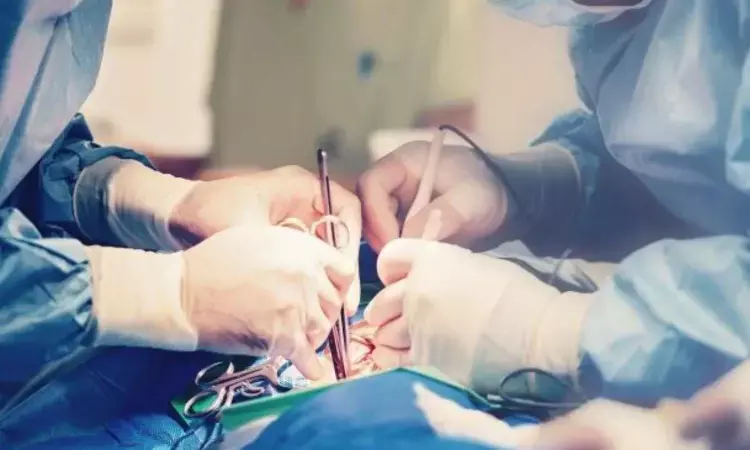- Home
- Medical news & Guidelines
- Anesthesiology
- Cardiology and CTVS
- Critical Care
- Dentistry
- Dermatology
- Diabetes and Endocrinology
- ENT
- Gastroenterology
- Medicine
- Nephrology
- Neurology
- Obstretics-Gynaecology
- Oncology
- Ophthalmology
- Orthopaedics
- Pediatrics-Neonatology
- Psychiatry
- Pulmonology
- Radiology
- Surgery
- Urology
- Laboratory Medicine
- Diet
- Nursing
- Paramedical
- Physiotherapy
- Health news
- Fact Check
- Bone Health Fact Check
- Brain Health Fact Check
- Cancer Related Fact Check
- Child Care Fact Check
- Dental and oral health fact check
- Diabetes and metabolic health fact check
- Diet and Nutrition Fact Check
- Eye and ENT Care Fact Check
- Fitness fact check
- Gut health fact check
- Heart health fact check
- Kidney health fact check
- Medical education fact check
- Men's health fact check
- Respiratory fact check
- Skin and hair care fact check
- Vaccine and Immunization fact check
- Women's health fact check
- AYUSH
- State News
- Andaman and Nicobar Islands
- Andhra Pradesh
- Arunachal Pradesh
- Assam
- Bihar
- Chandigarh
- Chattisgarh
- Dadra and Nagar Haveli
- Daman and Diu
- Delhi
- Goa
- Gujarat
- Haryana
- Himachal Pradesh
- Jammu & Kashmir
- Jharkhand
- Karnataka
- Kerala
- Ladakh
- Lakshadweep
- Madhya Pradesh
- Maharashtra
- Manipur
- Meghalaya
- Mizoram
- Nagaland
- Odisha
- Puducherry
- Punjab
- Rajasthan
- Sikkim
- Tamil Nadu
- Telangana
- Tripura
- Uttar Pradesh
- Uttrakhand
- West Bengal
- Medical Education
- Industry
Continuous suture of Biliary-enteric anastomosis safe and faster compared with interrupted suture

A new study by Lena Seifert and team showed that compared to interrupted suture, biliary-enteric anastomosis (BEA) continuous suture is quicker and similarly safe. The findings of this study were published in British Journal of Surgery.
Although either continuous suture or interrupted suture methods can be used to conduct biliary-enteric anastomosis, there is insufficient high-quality information to support the superiority of either method. In order to assess the suture procedures for patients undergoing BEA, this study was undertaken by examining the suture time as well as short- and long-term biliary problems.
Patients scheduled for an elective open surgery with a BEA between January 21, 2016, and September 20, 2017, were randomly assigned in a 1:1 ratio to have the BEA done using either the interrupted suture method (ISG) or the continuous suture technique (CSG). The main result was the length of time needed to perform the anastomosis. Secondary outcomes included morbidity and death up to day 30 following the intervention, survival, and BEA-associated postoperative sequelae with and without operational revision of the BEA, including bile leakage, cholestasis, and cholangitis.
The key findings of this study were:
1. A total of 82 patients were randomly assigned, and 80 of them (39 in ISG and 41 in CSG) got the assigned intervention.
2. Suture duration was greater in the ISG than the CSG (median (interquartile range), 22.4 (15.0-28.0) min versus 12.0 (10.0-17.0) min, OR 1.26, 95% c.i. 1.13 to 1.40; increase of 1 min; P 0.001).
3. There were comparable short- and long-term biliary problems between the groups.
4. Bile leakage was common (6 (14.6%) versus 4 (10.3%), P = 0.738), and it was equivalent between groups.
5. In neither group did anastomotic stenosis develop.
Reference:
Seifert, L., von Renesse, J., Seifert, A. M., Sturm, D., Meisterfeld, R., Rahbari, N. N., Kahlert, C., Distler, M., Weitz, J., & Reissfelder, C. (2023). Interrupted versus continuous suture technique for biliary-enteric anastomosis: randomized clinical trial. In BJS Open (Vol. 7, Issue 1). Oxford University Press (OUP). https://doi.org/10.1093/bjsopen/zrac163
Neuroscience Masters graduate
Jacinthlyn Sylvia, a Neuroscience Master's graduate from Chennai has worked extensively in deciphering the neurobiology of cognition and motor control in aging. She also has spread-out exposure to Neurosurgery from her Bachelor’s. She is currently involved in active Neuro-Oncology research. She is an upcoming neuroscientist with a fiery passion for writing. Her news cover at Medical Dialogues feature recent discoveries and updates from the healthcare and biomedical research fields. She can be reached at editorial@medicaldialogues.in
Dr Kamal Kant Kohli-MBBS, DTCD- a chest specialist with more than 30 years of practice and a flair for writing clinical articles, Dr Kamal Kant Kohli joined Medical Dialogues as a Chief Editor of Medical News. Besides writing articles, as an editor, he proofreads and verifies all the medical content published on Medical Dialogues including those coming from journals, studies,medical conferences,guidelines etc. Email: drkohli@medicaldialogues.in. Contact no. 011-43720751


